Site Menu:
| This is an archived Horseadvice.com Discussion. The parent article and menus are available on the navigation menu below: |
| HorseAdvice.com » Horse Care » Horse Pasture, Fencing, Barns » Bedding, Flooring, and Footing for Horses » |
| Discussion on Mulch or screenings for a dry lot? | |
| Author | Message |
| Member: cpacer |
Posted on Wednesday, Jan 23, 2008 - 3:20 pm: Hello,I'm sure this has been discussed, but there may be new and improved info out there!?! I want to have some kind of surface put down in my dry lot which has turned super muddy with all the recent rain. I'm torn between cypress mulch or screenings. Can anyone recommend which would be best? There are trees in this lot too (not sure if it makes a difference). Thank you! |
| Member: scooter |
Posted on Thursday, Jan 24, 2008 - 6:32 am: Hi cp what do you mean by dry lot? Is it a very big area? I would think that mulch would just make it more "goopier" but alot depends on location, if it is sloped, how many horses, how often it is used ect.? Need more info
|
| Member: canter |
Posted on Thursday, Jan 24, 2008 - 7:21 am: cp, at my barn, they use a course, mixed mulch between the barn and the pastures. In the spring, they put down a pretty thick layer (aprox 3") that they receive from a friend in the tree cutting business, and then spread the same again in the fall. Because the area slopes down to the pastures, it does wear thin in high traffic spots and in those spots, will get a little muddy, but overall, I think it is quite effective in keeping the whole area mud free, it looks nice and smells great right after it's laid down.My only complaint is that because it is not evenly ground up, occassionally, I will find a piece stuck in my mare's frog, or wedged under a shoe. But, it never has yet caused a problem and I think the benefits out weigh the one issue. |
| Member: cheryl |
Posted on Thursday, Jan 24, 2008 - 9:18 am: Not sure how much muck you end up with - I lived in W.Washington for 20+ years. The muck by the stall doors would get knee deep and stay that way for months - I tried course wood chips - ended up turning into more muck - Screenings solved the problem - If a place started to muck up a couple shovel-fulls of screenings put an end to it - I'm using screenings here in Idaho. This fall we managed to get by without any muck - we have clay soil down at least 5 feet - I know because I tried to dig past it to put in a drainage pit for the gutters on the back of the barn - We put down a thin layer - 1/2-1 inch thick - and had no muck in that area - That being said - if your horses are digging through it to get to roots because you are starving them slap to death - sand colic is a very real danger. - sand colic is a very real danger. Cheryl |
| Member: sonoita |
Posted on Thursday, Jan 24, 2008 - 10:25 am: I am sorry. Can someone tell me what screenings are?
|
| Member: deedles5 |
Posted on Thursday, Jan 24, 2008 - 10:38 am: Screenings can be very dusty in dry climates.Pea gravel is the best thing you can do for your horses feet and it drains well. |
| Member: cpacer |
Posted on Thursday, Jan 24, 2008 - 11:42 am: Now I thought Screenings and Pea Gravel were the same? So Pea gravel would be good for them to live on for 12-hours a day? They like to run around a lot and are barefoot, so I like the idea of them getting their feet toughened, but wouldn't want to cause chips or bruising.The area is small, maybe 1/4 acre or less. Eventually I may have 3 on there, but they only go in there during the hot humid summer days when most horses around here are in stalls under a fan. I need to use it now because those destructive little monsters are ripping up the pasture I planted in October. Sounds like I could go either way and be okay--now I'm torn even more. Think I'll call and see if there's a price difference between screenings and pea gravel! |
| New Member: smacemon |
Posted on Thursday, Jan 24, 2008 - 11:42 am: When I moved Lukas into his 35'x35' paddock, it was a mud pit. 24+ tons of "quarry finds" later, we are generally high and dry. I believe these are the same as "screenings" - smaller than 1/4" gravel; will ball up (like dirt) when squeezed in your hand. I like it better than pea gravel because it compresses and doesn't migrate. I tried to put the first load in when it was already muddy - big mistake! I ended up with a muddy paddock of quarry finds. Many folks where I board use these, or base rock (add 1/2" gravel to quarry finds)to keep their paddocks dry. The best (driest installations) are the ones that installed in dry or damp conditions, and are well tamped, either with a tamper, or the tractor run back and forth many times to compact the rock. This winter, I'm spot filling, and simply put a mat over the new finds and let Lukas do the compressing
|
| Member: annes |
Posted on Thursday, Jan 24, 2008 - 2:42 pm: When we put screenings around our barn area, my husband used a big roller filled with water and pulled behind the 4-wheeler. It was not expensive and really worked well. |
| Member: mysi |
Posted on Thursday, Jan 24, 2008 - 10:08 pm: CP- I have screenings in my isleway of my barn and around it(it was there when I moved in) and it's great BUT...I find that it gets super dusty. I mist it with the hose a couple times a week and that helps. As far a getting muddy, it doesn't, it is great in that way. Think of a riding ring, it's usually 1/2 screenings and think of the maintenance with those with the traffic. I guess everything horse related requires tons of maintenance though, grass, mulch, screenings... |
| Member: cpacer |
Posted on Friday, Jan 25, 2008 - 11:52 am: You said it Melissa, they sure are high maintenance! What I don't understand is how 2 horses can put a footprint on every single square inch of a 3 acre pasture?!?! |
| Member: lilo |
Posted on Saturday, Jan 26, 2008 - 9:28 am: Hi all - Wanda asked the question, and I have the same one: What are screenings?I find that there are different names for different products depending on where one lives - are screenings the same as roadbase, for instance? Roadbase, the way I understand it, has larger particles (maybe 1/4" to 1/2" but mixed in with fines - it packs down quite hard. Lilo |
| Member: cheryl |
Posted on Saturday, Jan 26, 2008 - 10:23 am: Screenings and fines are the same thing. I have no idea how many different names there are for the product. It's what's left over from crushing rock - is very fine has a lot of dust(?) that turns really hard when it gets wet - Under rubber mats it packs down almost to the consistency of cement. It is also the cheapest product by far - here it's less than 1/2 the cost of pea gravel -Cheryl |
| Member: cpacer |
Posted on Saturday, Jan 26, 2008 - 10:24 am: I think screenings are a mixture of small rocks & sand-like broken particles. I found the following picture--I think you can get different sized rocks, these seem a little big to me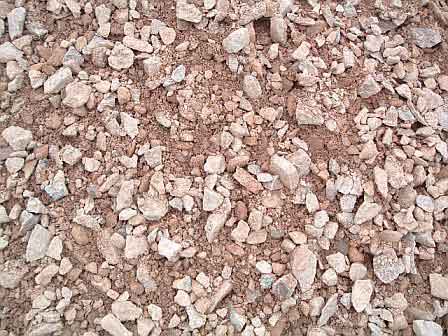
|
| Member: mysi |
Posted on Saturday, Jan 26, 2008 - 10:49 am: Way too big CP. That looks like what I would call ROCKS! Screenings are like a more coarse "sand". They come in many different grades, but nothing that looks like that. In Florida screenings are about $120-200 a truck load (delivered) depending on the grade. #1 is fill that is super soft and $120 and #5 is $200 and nice to top off a ring and good for drainage. Then #10 is like what someone called pea gravel, literally like rocks the size of peas, not sure of the cost of that because it's not something we had ever used for horses. My dad used it for landscaping when I was a kid. I'm starting to look into pricing for screenings here in NC for my ring, it needs an uplift. Everything is more expensive in S.FL so I hope the pricing is better here. Screenings are like a more coarse "sand". They come in many different grades, but nothing that looks like that. In Florida screenings are about $120-200 a truck load (delivered) depending on the grade. #1 is fill that is super soft and $120 and #5 is $200 and nice to top off a ring and good for drainage. Then #10 is like what someone called pea gravel, literally like rocks the size of peas, not sure of the cost of that because it's not something we had ever used for horses. My dad used it for landscaping when I was a kid. I'm starting to look into pricing for screenings here in NC for my ring, it needs an uplift. Everything is more expensive in S.FL so I hope the pricing is better here. Let me know what kind of pricing you find and I will do the same! |
| Member: scooter |
Posted on Saturday, Jan 26, 2008 - 1:36 pm: Hi Cp I have screenings in my paddock area and do love it....no mud at all. It would take an awful lot to do 1/4 an acre if you do it right anyway and would be plenty expensive. I have posted pic before of it, but here is what I consider screenings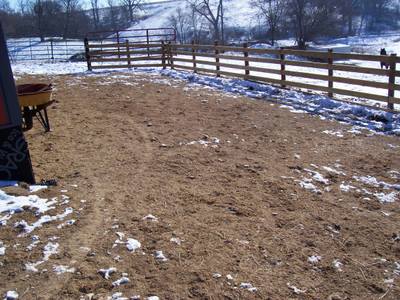 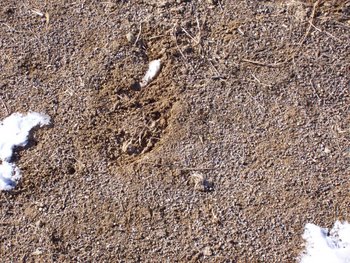
|
| New Member: smacemon |
Posted on Saturday, Jan 26, 2008 - 2:10 pm: As this discussion points out - different names for the same product, different products with the same name - depending on where you live and what quarry you purchase from. Here in Silicon Valley, decomposed granite is almost always the rock content; in other places, limestone content is higher, so the qualities of sand, findings, screenings, etc will be different.https://www.graniterock.com/constructionaggregates.html is one place I've found online that describes what they are selling. And their definitions are somewhat different than the Stevens Creek Quarry just down the street! I've had good luck going to the quarry (or their storefront), explaining what I need and listening to recommendations. I was lucky enough to talk to a guy who had worked with other horse-owners dealing with mud problems, so he had several suggestions. Delivery was more expensive than the rock itself, but I don't want to think about moving many tons of rock in my f150, >1/2 ton at a time! |
| Member: cpacer |
Posted on Saturday, Jan 26, 2008 - 5:57 pm: Yeah, I didn't think that looked right. You all have steered me to a decision though, I'm going to go with screenings as it seems like the better long term solution.The first estimate I got was $500 for 1 truck load (12 square yards I think), but I'll be calling around on Monday. |
| Member: mysi |
Posted on Saturday, Jan 26, 2008 - 7:22 pm: CP that's super expensive! Could something actually be cheaper in S.FL??? Wow!!! You'll need several truck loads for 1/4 acre won't you? |
| Member: scooter |
Posted on Saturday, Jan 26, 2008 - 8:14 pm: It took 6 truckloads for my paddock. It is very important to have a good base to put it on also. Mine is about a foot and a half deep minimum. ....packed down. I've had it in my paddock for 4 years and this year I will have to add some. It does slowly erode away in the rain....especially heavy down pours. Mine has a slope to it so the water will run off. It's good for the pasture it runs into anyway. It is very important to pack it down or it stays the consistency of sand and something I would not like to feed hay on. It does get very dusty in the summer when it's dry I water mine down a couple times a week. There are definitely pros and cons to it. I wouldn't trade it for anything personally, but don't know if I would want to pasture my horses on it. My paddock is approx. 50ft long by 32 wide I believe it cost around $600. The screening were cheap....like $2 a ton... the trucking and hiring a bob cat to spread and pack it was my biggest expense. |
| Member: paul303 |
Posted on Sunday, Jan 27, 2008 - 12:33 am: It's called screenings or stone dust in Jersey. We've used it a lot. There is also a product called "Dry Stall" sold in our feed stores. I've used it around the muddy gates with outstanding success. Put it down 3 years ago ( also around the water tubs in the pastures )and have not needed to re-do it. It's expensive, though, so I only used it in small areas. Used screenings/stone dust for the large areas. |
| Member: lilo |
Posted on Sunday, Jan 27, 2008 - 9:19 am: Lee - both a friend of mine and I emailed the Dry Stall people about a distributer here in Colorado, and never even got a response. We thought they had gone out of business.Lilo |
| Member: dres |
Posted on Sunday, Jan 27, 2008 - 11:09 am: We create winter paddocks to keep the horses off the pasture all rainy season.. we put down what we call a road base first and packed it down.. it took several truck and transfers and my little tractor to get it all done in one day.. We then add 3/4 crush rock around the gates.. most traffic areas.. And yes you have to add either every year or every other.. This last year we just went with a few pick up truck loads.. It was fine till the last rains we have had... Still not slop but it is not draining as well as it had.. Next summer we will be adding tons more..Another hint ... you might want to put some of this crush rock or road base or what ever you use down on your walking paths to and from the barn to paddocks / pastures / back door.. On the first day God created horses, on the second day he painted them with spots.. |
| Member: sonoita |
Posted on Sunday, Jan 27, 2008 - 9:49 pm: I think in Colorado it is called squeege. It does turn almost like concrete. Which I do not think my horses would like. I use mats now in front of my stalls and they seem to be working out good. My runs are cleaned daily so that cuts down on muck. And I do shovel or snow blow my runs. Can you say anal.
|
| Member: paul303 |
Posted on Monday, Jan 28, 2008 - 12:16 am: Lilo: Shoot! Out of business?? Rats! They're probably out of business because it worked so well. I've just never gotten mud again in the areas where I used it (around my gates and water tub ). And the very best thing about it was, the grass grew well in the areas where I used it. |
| Member: cpacer |
Posted on Monday, Jan 28, 2008 - 7:40 am: Squeege! I like that.I think the first quote I got was rather high, I hope to find a lot lower! I'll probably start with covering the high traffic areas of the dry lot and see how well that works. I tried contacting the Dry Stall people too and didn't get a response--too bad! |
| Member: lilo |
Posted on Monday, Jan 28, 2008 - 9:30 am: Lee - I am not sure. I think they have no distributor in Colorado and can't be bothered? I would think they would at least reply. Someone from that company actually posted here (there was a previous discussion that got me interested).Lilo |
| Member: lilo |
Posted on Monday, Jan 28, 2008 - 9:31 am: cp- I see you had trouble too. Lilo |
| Member: muffi |
Posted on Monday, Jan 28, 2008 - 2:26 pm: in n nm we call it Base Course.but. our soil is very clay like - we add Homemade Wood CHIPS not shavings. small chips of Cedar and Pine. only costs me time and muscle to get. plus sand, lots of Large granule Sand. The horses paddock off the barn is about the equavilant to a 50 round pen or more. with a tree smack dab in the middle. so we went through 2 truck loads of sand and yards and yards of that homemade Chips. it does also have a slope to it for run off. the lower end is shored up with Railroad Ties. but still goes slightly down hill. The mixture of Sand and Wood chips does well. I kind of keep them some what separated - the larger concentrations of sand vs the larger recent dumps of wood chips. they like to pee in the chips (geldings) cause it absorbs the splash and they nap inthe sand. I foresee adding sand every once in a while as it does work in to the dirt. Who ever said it is right How do they put foot prints over every available space? but no mud any more. it's wonderful for barefoot winter horses too. oh and it is about $30 a yard for the Base Course & a little more for Sand. We have a trailer and pick it up by the yard or selves to save delivery. We used base course all around the barn to make it level as it was build on the side of a hill. that and Many Many more Railroad ties on the down hill side. worked like a charm and looks nice too. also use gutters to pull rain and snow melt away from the arena area. best $20 investment my husband ever put up! (gutters) |
| Member: cpacer |
Posted on Wednesday, Feb 20, 2008 - 2:13 pm: I got my screenings down, so thought I'd share a picture of what mine look like.It is SOOO nice to have a mud-free place to put the boys after it rains!!! (kind of looks like the moon though) 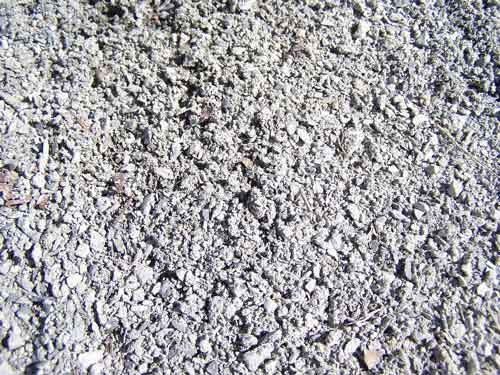 We call it the bachelor pad. They have all their toys in there and spy on the neighbors as they go by. 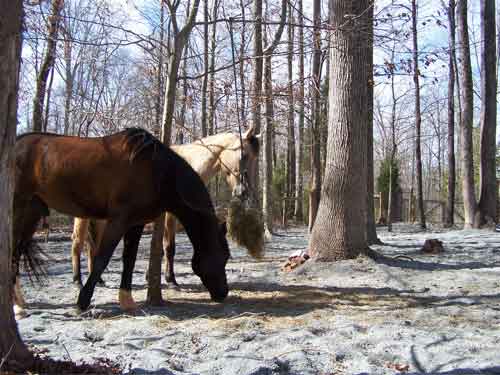
|
| Member: scooter |
Posted on Thursday, Feb 21, 2008 - 6:24 am: Cp that looks so nice and dry . I have to add I would be caution feeding them on it. My neighbors horses ended up with a bunch in her stomach and had to have surgery to remove it. . I have to add I would be caution feeding them on it. My neighbors horses ended up with a bunch in her stomach and had to have surgery to remove it. By the way your horses are VERY cute 
|
| Member: cheryl |
Posted on Thursday, Feb 21, 2008 - 8:23 am: CP - I will reiterate my above comment - screenings were the cause of the colic which caused the loss of THE greatest horse is the whole wide world. I use screenings and love them - but we built hay boxes for my guys to eat out of. They are just made out of what we had available - are large enough they can toss the hay around inside the box to find the little morsel they absolutely must have without tossing the hay out on the ground. I also dig out any grass that tries to grow through the screenings.CK |
| Member: cpacer |
Posted on Thursday, Feb 21, 2008 - 9:01 am: Thank you for the warning -- I stopped feeding grain in there for that reason, but I thought hay could be lipped up?Maybe I should put some stall mats down under the hay areas. I put hay bins in their stalls, but they throw it all over the place anyway. Is there anything I can do to help flush pebbles out of their system since they've probably ingested some? Now I'm worried again!!! Maybe I should have gone with mulch. UGH! |
| Member: cheryl |
Posted on Thursday, Feb 21, 2008 - 9:29 am: Sham didn't colic from eating hay off the ground - it was from digging through the screenings to get to grass roots - He was convinced he was being starved to death - Fox is expert at throwing hay out of hay boxes - We made these three feet deep and three or four feet wide - she has room to move the hay around and will still throw some of it out but nearly as bad as with a smaller box - There is way less hay wasted - I've had horses on screenings for years - wouldn't use anything else - I'm just careful about them eating off the ground.CK |
| Member: ekaufman |
Posted on Thursday, Feb 21, 2008 - 9:33 am: Pallets, like the ones they stack concrete or feed on, are free many places and can be assembled into nice hay ricks, with mats on the bottom and to form an apron for what they pull out.The horse.com posted an article saying that mineral oil+psyllium has some efficacy against sand. Most horses are careful about pebbles. I think the main thing is to try to prevent ongoing ingestion. |
| Member: scooter |
Posted on Thursday, Feb 21, 2008 - 5:55 pm: CP my neighbor just fed hay on it, but it was alfalfa hay. My guess is they were trying to get every last leaf and the screenings went with it. She removed all the screenings after that. Their was also some grass sprigs that would come through that they were trying to eat....it took about 6 mos. to build up enough where she coliced and I THINK they said she had around 40#'s in there....don't quite remember now but it was an ungodly amount. I would also recommend deep hay boxes we built some out of left over plywood where I use to keep the horses. They were about 3 foot deep so they couldn't/didn't throw any out.I don't think picking up a little here and there is going to hurt if some would happen to fall out. I still use the screenings and love it...I just don't feed on it. Is there a place that adjoins it that you could feed them...like a dry lot? |
| Member: cpacer |
Posted on Thursday, Feb 21, 2008 - 7:34 pm: I would love to see some pictures of these hay boxes for inspiration if possible!?! I've got plenty of left over wood from the barn building.I'm thinking some kind of wood base or frame with a top so the rain doesn't get in, and they can pull the hay out of the sides? Looks maybe like a rabbit hutch only a few inches off the ground, or is it really just a big box? Guess I'd still need stall mats or something for the stuff that falls. btw, that was my dry lot. |
| Member: cheryl |
Posted on Saturday, Feb 23, 2008 - 8:24 am: CP I meant to take pictures of the boxes yesterday and never did get around to it - They are nothing more than a wooden box without a top. We used that pressed wood stuff that is made out of wood shavings - for the sides on one - 2X6's on the other - we used treated 2X4's for runners on the bottom so the bottom wasn't sitting on the damp ground. Leaving a fairly large opening in the bottom makes it easy to clean the box - they are heavy and sweeping it out is much easier than having to dump them.CK |
| Member: remmi |
Posted on Friday, Oct 10, 2008 - 9:52 am: Hi all,I just finished building a 6 stall horse farm - and after alot of research and debate with myself, for the dry lot I removed the top soil and added 12 inches of limestone (screenings), compacted it, and then added Fibar (wood chips). It protects the horses from screening ingestion, plus thanks to Cheryl's earlier advice and pictures of her hay box I put in hay feeders - I just bought polytanks from Farm and Fleet - drilled holes in them so they drain, and the put rubber mats around the tanks. They still waste a little but much less than before. We have alot of wind so it keeps the hay from blowing too. I started with 3-4 inches of wood chips but found that to be too deep, so we reduced it to 2 inches. Still gives the horses a firm base to walk on but now they will roll in it, pee on it, and generally its a friendlier surface for them to stand on then plain screenings. Hopefully it will prevent hoofs from drying out too. I also found that it's a great surface to ride on - I can use my paddock as an outdoor arena. :-) |
| Member: dres |
Posted on Friday, Oct 10, 2008 - 11:21 am: Heidi, about how much rain to you all get? I am curious if the wood chips will get boggy? I know at other places where they have put down wood chips on top of pathways, after a good rain the pathway turned into a marsh.. Let us know how it turns out 1/2 way thru your wet months..On the first day God created horses, on the second day he painted them with spots. |
| Member: sodmonst |
Posted on Monday, Apr 6, 2009 - 1:29 am: Arizona is sandy (surprise!) and sand colic is a concern always. We have luck using a round galvanized water trough. The horses have plenty of space to push the hay around in it, and don't get it on the ground much. We also feed a daily dose of psyllium for a week out of each month. That helps to gently move any unwanted sand on through and out.Reading this discussion, I'm grateful that our paddock is built on a hillside. The water drains away well. On the other hand, brother in law did a similar fix to what Heidi describes in an area of Colorado where people fight the mud. He got an excellent result. |
| Member: stek |
Posted on Monday, Apr 6, 2009 - 10:28 am: Here in the pacific northwest many people use shredded cedar bark as mud control. I tried it on the first property we owned when we moved here and it had turned to sloppy non-draining soup after 1 year. It's fantastic for the first few months, but you really have to scrape it out and reapply fresh every year for maximum benefit.Hopefully though the limestone will allow it to drain well enough underneath and give it a longer life. Is the limestone base free-draining through to the sub base or does it pack to the point that the water sheets off of it? |
| Member: remmi |
Posted on Monday, Apr 6, 2009 - 1:09 pm: Ann, you asked about how much rain we get. Normal is 32 inches per year, but the last two years it has been much higher - lots of local flooding, etc. Now that I have had the Fibar on the screenings for about 6 months, I am finding that I really do like it. An unexpected benefit of the fibar this winter was the traction it provides when you get an ice storm. We had a couple of doozies this winter - the ice froze within the fibar but the fibar provided traction so the horses were still able to move around on the ice very well. I haven't had any issues with the fibar getting mushy or being too wet - it dries out quickly - maybe a day or two after a rain and it's dry again. The only part I don't like is around the feeding areas - I have very messy geldings and some of the hay mixes in with the fibar and then they add manure to the mixture and you end up wtih a softer area around the feed bins. We clean the paddock daily - so it's not too bad. It takes about a week for that area to dry up well after a big rain. Once we get the horses out on pasture we plan to clean up the area around the feeders and put new fibar down. So far I really am impressed with the fibar placed over the screenings. The horses sleep on it and it makes for an inviting place for them to live when they can't be out on pasture. |
is The Horseman's Advisor
Helping Thousands of Equestrians, Farriers, and Veterinarians Every Day
All rights reserved, © 1997 -
